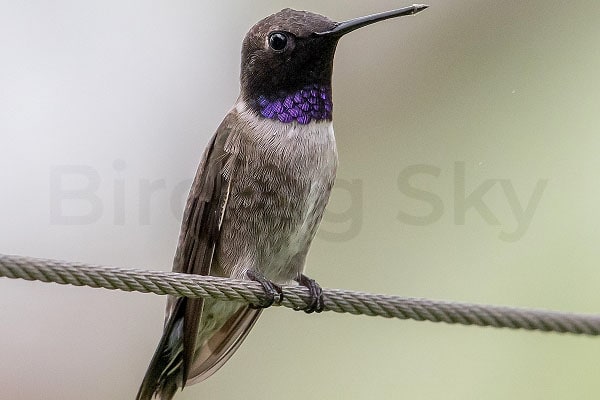Have you ever wondered how many different species of hummingbirds make Texas their home? Prepare to be amazed as we unveil the vibrant world of these tiny, feathered jewels that grace the Lone Star State. From the elusive Lucifer Hummingbird to the fiery Rufous Hummingbird, each species has its own unique charm and beauty. Get ready to explore the incredible diversity of hummingbirds that call Texas home, and learn how to identify them with our comprehensive ID guide and stunning photos.
Key Takeaways:
- Discover the 17 species of hummingbirds that can be found in Texas.
- Learn how to identify each species with our detailed ID guide.
- Get a close-up look at these captivating creatures with our stunning photos.
- Explore the distinct features, behaviors, and habitats of each species.
- Uncover the hidden gems of Texas by spotting these beautiful hummingbirds in the wild.
1. Ruby-throated hummingbird

The ruby-throated hummingbird is a captivating Texas hummingbird species that can be easily spotted throughout the state. With its vibrant plumage and unique features, it stands out among the various hummingbird species found in Texas.
Behavior and Habitat:
The ruby-throated hummingbird is known for its agility and quick movements. It hovers in mid-air and can fly backwards, sideways, and even upside down. These hummingbirds prefer open woodlands, gardens, and flower-filled areas where they can feed on nectar-rich flowers.
“The ruby-throated hummingbird is a delightful little creature that brings joy to any garden or nature enthusiast. Its vibrant colors and unique behaviors make it a beloved visitor in Texas.”
“The male ruby-throated hummingbird flashes its vibrant red throat in a display of beauty and territorial dominance, attracting not only females but also the attention of birdwatchers.”
| Species | Identification | Habitat |
|---|---|---|
| Ruby-Throated Hummingbird | Male: vibrant red throat, green upperparts, and wings; Female: white underside, green upperparts, and wings. | Open woodlands, gardens, and flower-filled areas. |
2. Broad-Tailed Hummingbird
Spot the broad-tailed hummingbird in Texas with our helpful tips for identification. This beautiful species is a common sight in the state and is known for its unique characteristics.
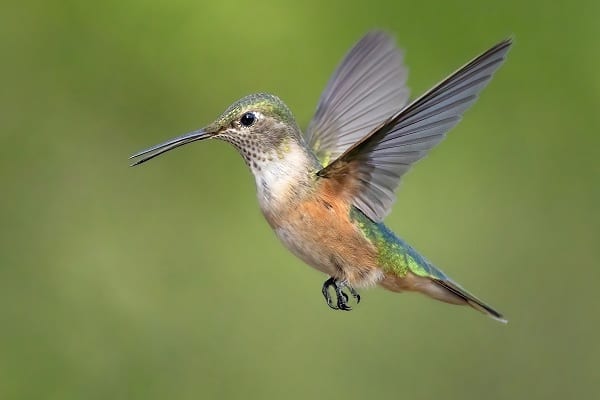
The broad-tailed hummingbird can be easily recognized by its distinct tail shape, which is broad and squared-off compared to other hummingbird species. Its vibrant iridescent feathers add to its charm and make it a delight to observe.
When identifying this hummingbird, look for the male’s vibrant green back and crown, as well as its impressive gorget, which shines in shades of magenta or ruby-red. The female has a more subdued appearance, with a grayish-green back and a lightly streaked throat.
These stunning birds prefer high-elevation habitats, such as mountainous areas with coniferous forests. During the breeding season, they can be found in the cooler parts of the state, including the Davis Mountains and the Guadalupe Mountains.
Broad-tailed hummingbirds are migratory, spending their winters in Mexico and Central America. They typically arrive in Texas during late spring and stay until early fall, providing ample opportunities for birdwatchers to spot these magnificent creatures.
Broad-Tailed Hummingbird Characteristics
| Characteristic | Description |
|---|---|
| Tail Shape | Broad and squared-off |
| Feather Color | Iridescent, vibrant |
| Male Back and Crown Color | Vibrant green |
| Male Gorget Color | Shades of magenta or ruby-red |
| Female Back Color | Grayish-green |
| Female Throat | Lightly streaked |
| Habitat | High-elevation areas with coniferous forests |
| Migration | Winter in Mexico and Central America, arrives in Texas during late spring |
3. Buff-Bellied Hummingbird
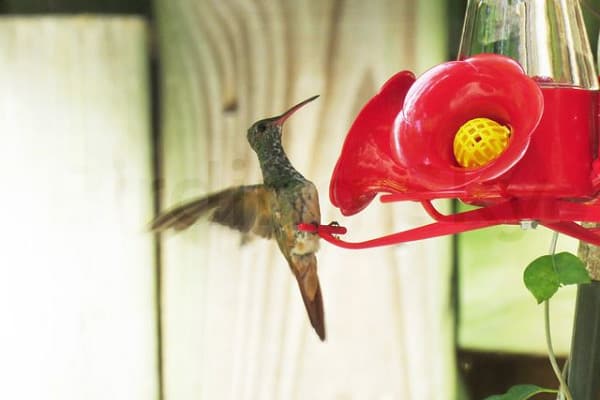
When it comes to Texas hummingbird species, the buff-bellied hummingbird stands out with its stunning colors and unique markings. This medium-sized hummingbird is primarily found in the coastal regions of Texas, making it a special sight for bird enthusiasts.
So how can you distinguish the buff-bellied hummingbird from other similar species? Look for these distinguishing features:
- Vibrant Colors: The male buff-bellied hummingbird showcases a vibrant mix of green, blue, and bronze feathers on its upperparts, while its underparts have a characteristic buff-colored patch on the belly, giving it its name. The female, on the other hand, has a more muted color palette with greenish upperparts and a light buff-belly.
- White Under-Tail Coverts: One key feature that sets the buff-bellied hummingbird apart is its white under-tail coverts. These white feathers contrast with the bird’s darker plumage and are noticeable when it is perched or in flight.
- Curved Bill: The buff-bellied hummingbird has a slightly curved bill, which is an important characteristic to look for when trying to identify this species.
Spotting the buff-bellied hummingbird in Texas can be a truly rewarding experience. Its preferred habitats include coastal woodlands, gardens, and parks with abundant nectar sources. The buff-bellied hummingbird is a migratory species, with individuals arriving in Texas in late winter and staying until the breeding season in early summer.
Get a closer look at the buff-bellied hummingbird with the captivating photo above and be mesmerized by its beauty and grace. Keep your eyes peeled for this enchanting Texas hummingbird species during your next outdoor adventure!
4. Blue-throated mountain Gem
Discover the beauty of the Blue-Throated Mountain Gem, a hummingbird species that can be found in certain regions of Texas. With its stunning blue throat, this bird is a true gem in the world of hummingbirds. If you want to spot the Blue-Throated Mountain Gem in Texas, keep an eye out for its preferred mountainous habitats.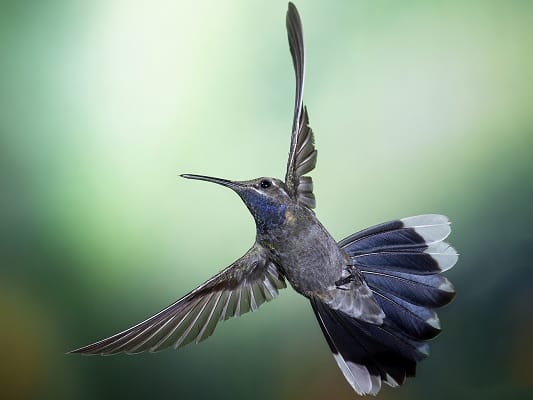
Identifying the Blue-Throated Mountain Gem can be a rewarding challenge. Look for its distinct blue throat and metallic green back. The male of this species has a glittering iridescent throat that shimmers in the sunlight, while the female has a more subtle coloration.
To increase your chances of spotting the Blue-Throated Mountain Gem, head to regions in Texas with higher elevations, such as the Davis Mountains or the Chisos Mountains in Big Bend National Park. These mountainous areas provide the perfect habitat for this species.
Don’t forget to bring your binoculars and a field guide to hummingbirds when embarking on your Blue-Throated Mountain Gem spotting adventure. These tools will help you identify the unique characteristics of this species and distinguish it from other hummingbird species found in Texas.
With its vibrant blue throat and preference for mountainous habitats, the Blue-Throated Mountain Gem is a true Texas treasure. Keep your eyes peeled and your field guide handy to spot this stunning hummingbird species in the Lone Star State.
5. Black-Chinned Hummingbird
Get ready to explore the fascinating world of the black-chinned hummingbird, one of the most common hummingbird species found in Texas. This beautiful bird is known for its unique black-colored chin and its subtle yet striking coloration.
Identification
Identifying the black-chinned hummingbird can be an exciting challenge for bird enthusiasts. Here are some key features to look out for:
- The male black-chinned hummingbird has a glossy green back, a dark throat with a vibrant purple band, and a black chin, while the female has a green back, white throat, and a white belly.
- Both genders have a narrow white stripe behind their eyes and long, slender bills.
These distinct characteristics will help you correctly identify the black-chinned hummingbird when you encounter it in the field.
Where to Find the Black-Chinned Hummingbird in Texas
If you’re eager to spot the black-chinned hummingbird in Texas, here are some prime locations to visit:
- The Davis Mountains: This mountain range in West Texas is a popular spot for hummingbird migration and is a great place to observe the black-chinned hummingbird in its natural habitat.
- Big Bend National Park: Located in the Chisos Mountains, this stunning national park is another hotspot for hummingbird activity. Keep an eye out for the black-chinned hummingbird as it flits among the desert flowers.
- South Padre Island: This beautiful island along the Gulf of Mexico is not only a beach lover’s paradise but also a haven for birdwatchers. Visit the South Padre Island Birding and Nature Center for a chance to spot the black-chinned hummingbird among other fascinating avian species.
By exploring these areas, you’ll increase your chances of witnessing the mesmerizing black-chinned hummingbird up close.
Comparison of Texas Hummingbird Species
| Hummingbird Species | Distinctive Features | Habitat | Migration Pattern |
|---|---|---|---|
| Black-Chinned Hummingbird | Black chin, glossy green back, purple throat band | Mountains, desert, coastal areas | Spring and fall migrator |
| Ruby-Throated Hummingbird | Male with vibrant ruby-red throat, green back | Woodlands, gardens, meadows | Spring and fall migrator |
| Broad-Tailed Hummingbird | Incredible wings trill, iridescent throat | Mountains, meadows, forests | Summertime breeding resident |
| Buff-Bellied Hummingbird | Buff-colored belly, green back, white throat | Coastal areas, woodlands | Year-round resident |
Experience the wonder of Texas hummingbird species by exploring the diverse habitats where they can be found.
6. Calliope Hummingbird

Dive into the fascinating world of the Calliope Hummingbird, one of the many amazing Texas hummingbird species. Known for its tiny size and distinctive markings, the Calliope Hummingbird is a captivating sight for birdwatchers and nature enthusiasts.
This species prefers mountainous habitats, making it a unique addition to the hummingbird population in Texas. During migration, the Calliope Hummingbird can be found in the western regions of the state, providing lucky observers with the opportunity to spot this elusive bird.
Identifying the Calliope Hummingbird can be challenging due to its small size and similar appearance to other hummingbird species. Look for its green back and crown, along with the vibrant magenta streaks on the male’s throat. Females have a whiter throat with some subtle streaking.
“The Calliope Hummingbird is a delight to encounter with its iridescent plumage and rapid wingbeats,” says experienced birder, Jane Thompson. “Look for them in nectar-rich flowers and feeders, as they have a voracious appetite.”
If you’re hoping to catch a glimpse of the Calliope Hummingbird in Texas, keep an eye out for their preferred habitat of open woodlands, pine forests, and mountain meadows. These tiny creatures are known for their agility in flight, so be patient and watch for their distinctive darting movements.
Tips for Spotting the Calliope Hummingbird
- Set up hummingbird feeders with sugar water in your backyard or local park.
- Plant native flowers and shrubs that attract hummingbirds, such as bee balm and trumpet vine.
- Visit hummingbird hotspots in Texas, such as Big Bend National Park or Davis Mountains State Park.
- Listen for the high-pitched buzzing sound that calliope hummingbirds make during flight.
- Watch for quick and agile movements as they dart from flower to flower.
With some patience and a little luck, you may have the opportunity to witness the beauty of the Calliope Hummingbird in Texas. Keep your camera ready and cherish the moments you’re able to capture these mesmerizing creatures in action.
| Calliope Hummingbird | Facts |
|---|---|
| Scientific Name | Selasphorus calliope |
| Size | Approximately 3.25 inches in length |
| Habitat | Mountainous regions, pine forests, open woodlands, mountain meadows |
| Migratory Patterns | Presents during migration in western Texas |
| Distinctive Features | Green back and crown Vibrant magenta streaks on male’s throat Females have a whiter throat with subtle streaking |
| Preferred Food | Nectar from flowers and hummingbird feeders |
7. Rufous Hummingbird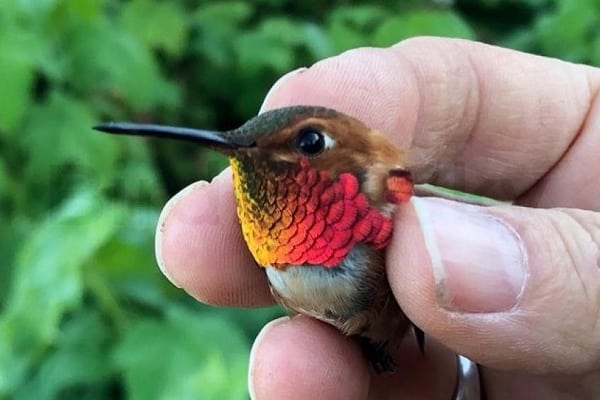
Experience the striking beauty of the Rufous Hummingbird, one of the many hummingbird species that migrates to Texas. With its vibrant colors and unique characteristics, the Rufous Hummingbird is a sight to behold. Let’s dive into the details of this fascinating bird and learn how to spot it in the Lone Star State.
Identification and Characteristics
The Rufous Hummingbird is best known for its fiery reddish-brown plumage and orange-red throat, which distinguishes it from other hummingbird species. This tiny bird measures approximately 3 to 4 inches in length, making it easily identifiable. Its wings beat rapidly, creating a buzzing sound as it hovers in mid-air.
“The Rufous Hummingbird’s brilliant colors and its ability to migrate long distances are truly remarkable.” – Hummingbird enthusiast
During migration, Texas provides a crucial stopover for these birds as they travel from their breeding grounds in the Pacific Northwest to their wintering grounds in Mexico and Central America. They can be spotted in Texas during the spring and fall seasons, making their presence a delightful treat for birdwatchers and nature enthusiasts.
Preferred Habitats
The Rufous Hummingbird favors a variety of habitats, including forests, meadows, gardens, and even urban areas with ample nectar sources. They are attracted to flowering plants such as bee balm, sage, and trumpet vine, which provide them with the necessary nectar to fuel their energy-demanding flights.
Spotting the Rufous Hummingbird in Texas
If you want to catch a glimpse of the Rufous Hummingbird in Texas, keep an eye out for its distinct reddish-brown feathers and orange-red throat. You can often find them visiting hummingbird feeders or foraging among flowers for nectar. Look for their small size and rapid wingbeats, which help them maneuver with agility.
Remember to offer a welcoming environment for these beautiful creatures by providing a hummingbird feeder with a sugar-water solution or by planting nectar-rich flowers in your garden. Be patient and observant, and you may be rewarded with the sight of a Rufous Hummingbird.
| Rufous Hummingbird Facts | Additional Information |
|---|---|
| Scientific Name | Selasphorus rufus |
| Size | 3 to 4 inches |
| Wingspan | 4 to 4.5 inches |
| Weight | Around 0.12 ounces (3.5 grams) |
| Migratory Pattern | Spring: From Pacific Northwest to Mexico and Central America Fall: From Mexico and Central America to Pacific Northwest |
8. Lucifer Hummingbird
Uncover the mystique of the Lucifer hummingbird, a rare species that can be found in certain regions of Texas.
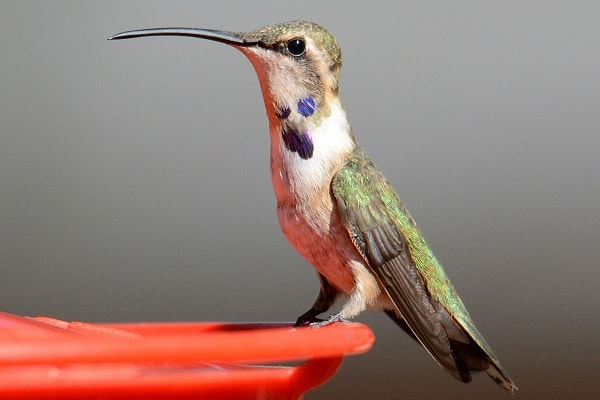
This captivating hummingbird species is known for its striking plumage, which includes shimmering emerald-green feathers on its back and a vibrant magenta throat. These bold colors make the Lucifer hummingbird a true delight to spot in the wild.
To identify the Lucifer hummingbird, look for its long, slightly decurved bill and a white stripe behind the eye, which contrasts against its dark-colored head and neck. The male also has a distinctive black face mask, adding to its unique beauty.
When searching for the Lucifer hummingbird in Texas, head to the southwestern parts of the state, particularly in the Big Bend region and the nearby Davis Mountains. These areas offer suitable habitats with desert scrub and thorn forest, where the Lucifer hummingbird can be found feeding on nectar from desert plants such as ocotillo and agave.
Remember to be patient and observant when searching for this elusive species. A keen eye, a pair of binoculars, and a field guide will greatly enhance your chances of spotting the Lucifer hummingbird in its native Texas habitat.
9. Anna’s Hummingbird
Uncover the enchanting beauty of Anna’s hummingbird, a captivating species that graces Texas with its presence throughout the year. With its vibrant plumage and sparkling iridescent gorget, Anna’s hummingbird is a true jewel of the avian world.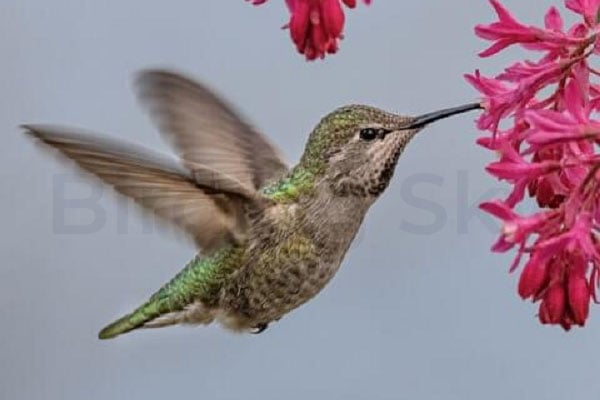
Identifying Anna’s hummingbird can be an exciting challenge for bird watchers. This species exhibits a range of distinct features, including its medium-sized build, green back, and cinnamon-colored flanks. The male boasts a striking iridescent pink-red gorget that shimmers in the sunlight, while the female dazzles with subtle green and gray tones.
If you’re eager to spot Anna’s hummingbird in Texas, there are a few key locations and times to keep in mind. This species can be found in a variety of habitats, including gardens, parks, and woodland areas. They are attracted to nectar-producing plants such as the Mexican honeysuckle (Justicia spicigera) and other native flowers. Keep your eyes peeled during their frequent visits to hummingbird feeders.
While Anna’s hummingbird is a resident species in Texas, sightings can be more common during the winter months when other hummingbird species migrate south. So, make sure to have your binoculars handy and be patient, as these feisty little birds are known for their quick movements and aerial acrobatics.
Whether you’re a seasoned bird watcher or simply a nature enthusiast, encountering Anna’s hummingbird in Texas is a special experience. Take a moment to appreciate their delicate beauty and watch as they gracefully flutter from flower to flower, bringing joy and wonder to the Texan landscape.
10. Broad-Billed Hummingbird
Discover the unique characteristics of the Broad-Billed Hummingbird, a striking species known for its colorful bill. These small birds can be found in Texas and are a treat to spot in the wild.
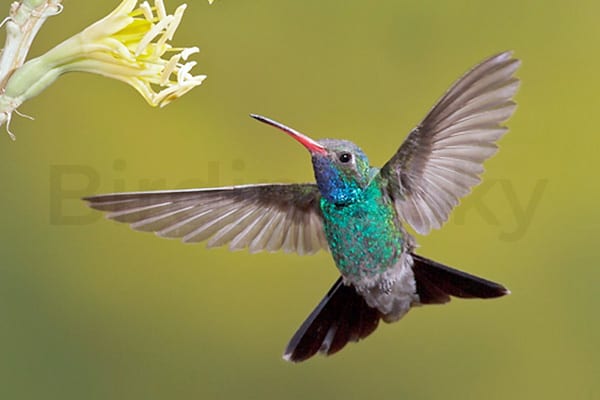
The Broad-Billed Hummingbird is easily identified by its vibrant bill, which is broad and straight. The bill’s bright colors, reflecting shades of red, orange, and yellow, make it stand out among other hummingbird species. This distinctive feature earns the bird its name and makes it a favorite among birdwatchers.
When it comes to habitat preferences, the Broad-Billed Hummingbird favors riparian areas, which are landscapes near rivers or streams with dense vegetation for cover and abundant nectar sources. These habitats provide the ideal environment for the bird to forage and nest.
Migration patterns play a significant role in the Broad-Billed Hummingbird’s presence in Texas. While these hummingbirds primarily breed in the southwestern United States and northern Mexico, some individuals migrate to Texas during their non-breeding season. This makes Texas a prime location for spotting Broad-Billed Hummingbirds at specific times of the year.
Identification Tips
Here are some key characteristics to help you identify a Broad-Billed Hummingbird in Texas:
- The colorful, broad bill is the most distinctive feature of the Broad-Billed Hummingbird.
- Look for the bird’s striking plumage, which typically includes shades of green on the upperparts and a contrasting white or pale gray throat.
- Pay attention to the bird’s size; it is relatively small, measuring around 3.5 to 4 inches in length.
Spotting a Broad-Billed Hummingbird in Texas can be an exciting experience for bird enthusiasts. Keep these identification tips in mind along with the bird’s preferred habitat and migration patterns for a better chance of encountering this beautiful species.
Other Hummingbird Species in Texas
In addition to the well-known hummingbird species in Texas, such as the ruby-throated hummingbird and the broad-tailed hummingbird, several other remarkable species can be observed in this beautiful state.
One of these fascinating species is the magnificent hummingbird. With its vibrant green plumage and magnificent size, it is truly a sight to behold. Look for this stunning bird in the southernmost parts of Texas, where it can be spotted during its migration.
Another hummingbird species to watch out for is Allen’s hummingbird, which showcases a breathtaking combination of green and coppery colors. Keep an eye out for its distinctive orange-red throat patch as you explore the coastal areas of Texas.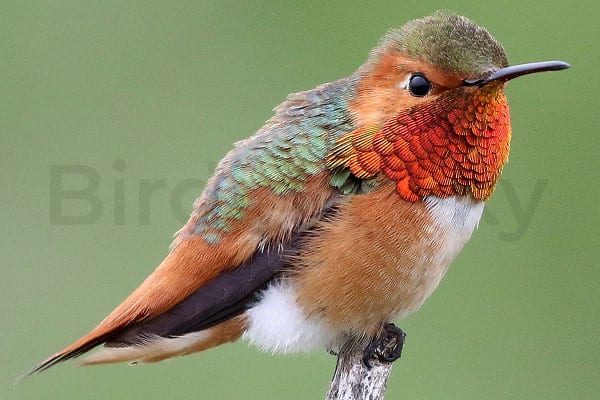
The white-eared hummingbird is yet another gem that can be observed in Texas. Known for its white ear patch, this species prefers the border regions of the state, particularly in the Big Bend area.
If you’re lucky, you might also catch a glimpse of the Mexican violetear, violet-crowned hummingbird, berylline hummingbird, or green-breasted mango during your birdwatching adventures in Texas. Each of these species brings its unique beauty and charm to the hummingbird world.
So, as you set out to explore the hummingbird species in Texas, don’t forget to keep an eye out for these magnificent birds. Their remarkable colors, distinctive features, and enchanting behaviors make them a true delight for any bird enthusiast.
You might be interested to read more about these species:
Hummingbirds Found in Wisconsin
Frequently Asked Questions
Q1: What months are hummingbirds in Texas?
Hummingbirds are typically present in Texas from March to October, with peak activity during the warmer months.
Q2: Are hummingbirds found in Texas?
Yes, hummingbirds are found in Texas and are a common sight, especially during the spring and summer months.
Q3: Where can I see hummingbirds in Texas?
Hummingbirds can be observed in various habitats across Texas, including gardens, parks, and areas with flowering plants. Setting up hummingbird feeders can also attract them to your backyard.
Q4: What town in Texas do the hummingbirds migrate to?
Hummingbirds don’t migrate to a specific town in Texas. Their migration routes cover different regions, and their presence depends on the availability of food sources.
Q5: Does Dallas have hummingbirds?
Yes, Dallas is home to hummingbirds, and they can be spotted in and around the city, particularly in areas with suitable nectar-rich plants.
Q6: Do hummingbirds stay in Texas all winter?
Some hummingbird species, like the Ruby-throated Hummingbird, migrate south for the winter. However, certain species and individuals may stay in Texas year-round, especially in the milder southern regions.

